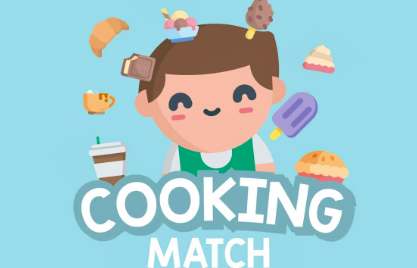
Cooking Match 3 Puzzle Game: A Fun, Educational, and Engaging Experience for Kids on Gridplay
In today's digital age, finding the right balance between fun and learning for children can be challenging. As a parent who's spent years navigating the world of kids' games—both online and off—I've seen firsthand how the right activity can spark joy while quietly building essential skills. Parents are constantly on the lookout for activities that not only entertain but also contribute to their child's development. Enter Cooking Match 3 Puzzle Game, a captivating HTML5 mini-game hosted on Gridplay. This browser-based puzzle game, accessible at Cooking Match on Gridplay, is designed specifically for kids, blending the excitement of matching puzzles with a culinary theme that sparks creativity and curiosity. Already indexed by Google, this game is gaining traction among families seeking free, safe online entertainment.
As a platform that's been live for nearly five months, Gridplay.biz.id offers a curated selection of high-quality mini-games, and Cooking Match stands out as a gem in our kids' category. In this comprehensive guide, we'll explore everything you need to know about the game: from its core mechanics and educational benefits to practical tips for parents and why it's a top choice for family gaming. Whether you're a parent introducing your child to online puzzles or a young player eager to dive in, this article will show you how Cooking Match can be a positive addition to your routine—always with mindful supervision and time limits in place. I've drawn from my own experiences raising two curious kids, as well as insights from educators and other parents, to give you a well-rounded view.
Understanding Cooking Match 3 Puzzle Game: A Delightful Blend of Fun and Strategy
At its heart, Cooking Match 3 Puzzle Game is a classic match-3 puzzle infused with a cooking twist. Players are presented with a grid filled with vibrant icons representing various ingredients—think juicy fruits, fresh vegetables, aromatic spices, and other kitchen staples. The objective is simple yet engaging: swap adjacent ingredients to form horizontal or vertical lines of three or more matching items. When a match is made, the ingredients disappear, points are scored, and new ones cascade down to fill the gaps, potentially creating chain reactions for bonus points.
What makes this game particularly appealing for kids is its thematic focus on cooking, which turns abstract puzzle-solving into something relatable and imaginative. Instead of just matching colors or shapes, children feel like they're whipping up recipes in a virtual kitchen. From my perspective as someone who's watched kids play similar games, this theme adds a layer of pretend play that keeps them hooked longer than generic puzzles. The game's description captures it well: it's "fun and exciting," allowing players to "match the ingredients to create your culinary masterpiece" and "combine the ingredients together to make them sate your hunger." It's addictive in the best way, providing hours of entertainment without overwhelming complexity.
Hosted on Gridplay, this free HTML5 game requires no downloads and runs smoothly on any device—phones, tablets, or computers. It's categorized under "kids," making it family-friendly, but don't be surprised if adults sneak in a few levels too. The visuals are bright and inviting, with animations that celebrate each successful match, reinforcing a sense of achievement. However, like any game, it's not without its challenges; levels ramp up in difficulty, introducing time limits, obstacles, and special goals that require strategic thinking.
From an educator's viewpoint—I've chatted with teachers who incorporate digital tools in classrooms—this game aligns well with early learning objectives. It encourages pattern recognition and logical sequencing, skills that translate directly to subjects like math and science. But let's not get ahead; we'll dive deeper into the benefits next.
Educational and Developmental Benefits: More Than Just Playtime
One of the biggest draws for parents is how Cooking Match supports child development without feeling like "homework." Drawing from studies and real-world observations, puzzle games like this one offer a host of cognitive perks. For instance, research from organizations like the American Society for the Prevention of Cruelty to Children highlights how puzzles enhance problem-solving, spatial reasoning, and memory. In Cooking Match, kids must scan the grid, plan swaps, and anticipate outcomes—skills that build executive function, a key predictor of academic success.
Visual-spatial reasoning gets a workout too. Matching ingredients hones the ability to discern shapes, colors, and patterns, which is foundational for reading and math readiness. I've seen this in action with my own children; after playing match-3 games, they became better at spotting details in books or even assembling real puzzles at home. Studies on matching games also point to improvements in fine motor skills through tapping and dragging, especially on touchscreens, which refines hand-eye coordination for toddlers and preschoolers.
Creativity is another winner here. The cooking theme inspires kids to think about food in new ways, perhaps sparking interest in helping out in the kitchen. Subtly, it promotes healthy eating awareness by featuring nutritious ingredients, countering the junk-food overload in some media. On the emotional side, overcoming tough levels teaches perseverance and resilience—valuable life lessons. As one study on educational puzzle games for 5-6-year-olds noted, these activities stimulate cognitive growth, showing marked improvements in attention and processing speed.
But it's not all rosy; some parents worry about screen time leading to overstimulation. From a balanced perspective, when moderated, games like this provide stress relief, as noted in articles on match-3 benefits. The rhythmic matching can be meditative, helping kids unwind after school. Morally, it fosters values like hard work and strategy over luck, building self-esteem through earned progress. Compared to passive video watching, active puzzles like Cooking Match engage the brain more deeply, making them a smarter choice for digital play.
How to Play: A Step-by-Step Guide for Beginners and Pros
If you're new to match-3 games, don't worry—Cooking Match is intuitive enough for kids as young as 4 or 5, with a bit of guidance. Start by heading to Cooking Match on Gridplay and launching it in your browser. The first levels introduce basics: swap two adjacent ingredients by clicking or tapping, aiming for lines of three or more.
As you progress, objectives evolve—collect specific ingredients, clear jelly-covered tiles, or hit score targets within moves or time limits. Power-ups add excitement: match four in a row for a striped ingredient that blasts a whole line, or form an L-shape for a bomb that explodes nearby items. Chain reactions, where one match triggers others, rack up big scores and feel incredibly satisfying.
For advanced play, focus on board control—clear bottom rows first to cascade more pieces, or save boosters for sticky situations. Kids love the "aha" moments when a clever swap turns the tide. If you're playing with your child, take turns; it turns solo play into a bonding activity.
Tips for Parents: Making Gaming Positive and Safe
As a seasoned parent, I can't stress enough the importance of guidance. Set clear time limits—maybe 30-45 minutes a day—to prevent overuse, aligning with pediatric guidelines that suggest balanced screen time. Supervise sessions to discuss strategies, turning play into teachable moments: "What ingredient do you need next? Why?" This reinforces learning.
Encourage tying the game to real life—after a session, try a simple recipe with matched ingredients, like a fruit salad. Address potential downsides: if a child gets frustrated, pause and talk about trying again later, building emotional regulation. Share progress via the game's "Share This Game" feature to involve grandparents or friends, fostering community.
From other parents' views, shared in online forums like Reddit, many appreciate educational games for brain exercise but emphasize variety—mix with outdoor play or board games. Some note that puzzle games help with focus in hyperactive kids, while others caution against addictive loops, suggesting apps with parental controls.
Parent Perspectives: Real Stories and Insights
Speaking to parents, perspectives vary but lean positive. One mom I know raved about how match-3 games improved her son's attention span, echoing research where parents see puzzles as tools for mild autism support through fun logic challenges. In studies on home puzzle play, families report natural variability—some kids dive deep into strategy, others enjoy the colors—highlighting individualized benefits.
On the flip side, a teacher friend pointed out that not all games are equal; those with ads or in-app purchases can distract, but Cooking Match's ad-free setup on Gridplay avoids this. Parents in surveys prefer games that reward effort, like achieving in-game goals, which builds intrinsic motivation. Overall, the consensus is that supervised puzzle play enriches, not replaces, traditional activities.
Why Choose Cooking Match on Gridplay.biz.id?
Gridplay stands out for its commitment to safe, free gaming. No sign-ups, no hidden fees—just pure fun. Compared to app stores cluttered with monetized titles, our platform curates quality HTML5 games, with Cooking Match as a standout in puzzles and kids. It's Google-indexed, easy to find, and optimized for all devices.
Potential drawbacks? Like any digital game, it might not suit every child—those preferring action over strategy could explore other Gridplay options. But for culinary puzzle fans, it's ideal. Integrate it into routines: use as a reward or family challenge.
In wrapping up, Cooking Match 3 Puzzle Game is a flavorful adventure that educates while entertaining. From boosting cognition to teaching resilience, it's a win for kids and parents. Head to Gridplay or directly to the game today. As someone who's seen the spark in a child's eyes during play, I highly recommend it—with boundaries, of course. Happy matching!
